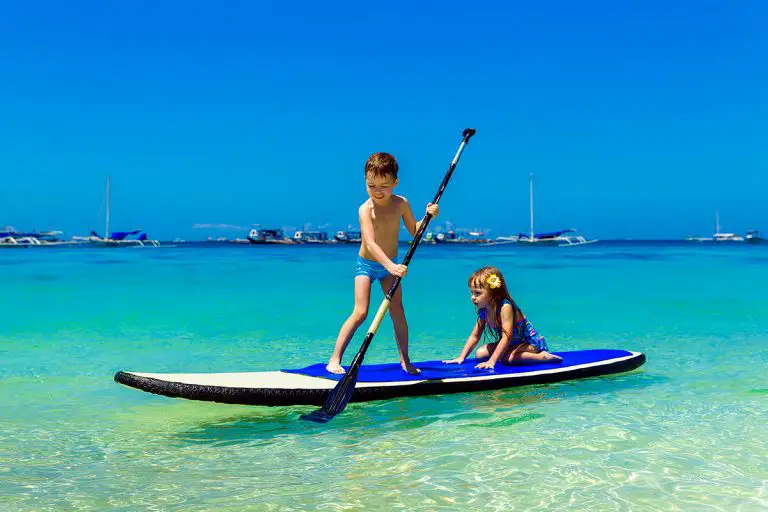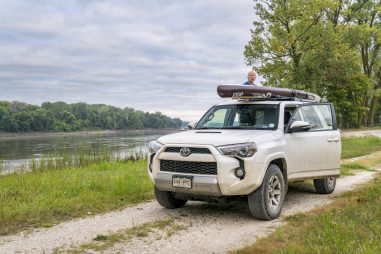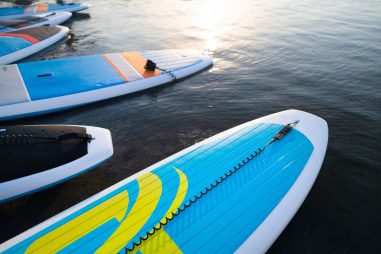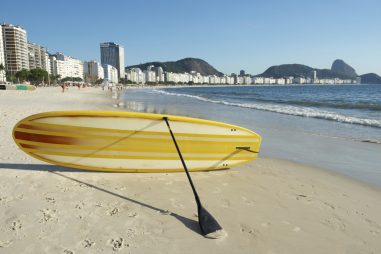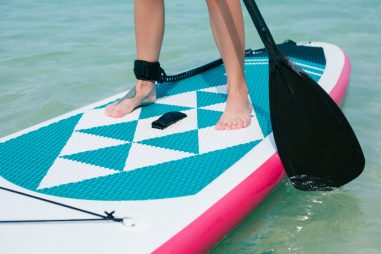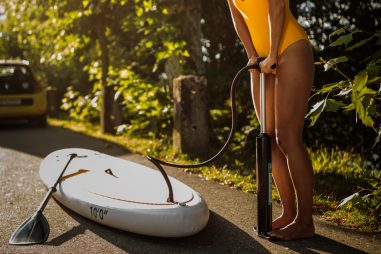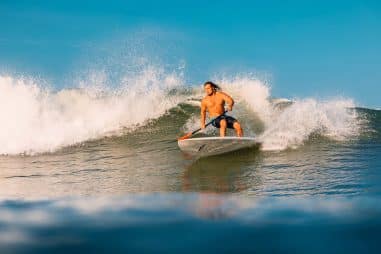Paddle boarding continues to be popular all over the world because it is inclusive in terms of the people who can do the sport. Whether you are a child or 60 years old, you can still learn and enjoy paddle boarding. If you want to know how you can bring your child with you out on your paddle board, then read on!
How Old Do You Have to Be to Paddle Board?
Paddle boarding is truly a sport for people of all ages. Children as young as eight (8) years of age can start their solo paddle boarding journey provided that they know how to swim and are comfortable with the water. If you have children younger than that, you can still have them on the paddle board with you but just make sure that you are a skilled paddle boarder and your board is just the right size.
There are a lot of upsides to starting your kids young in paddle boarding. The sport can improve their balance, focus, and strength at such a young age. Paddle boarding can also boost their confidence. Being surrounded by nature and having the shared quality time between you and your kids can contribute to their growth as individuals.
How Do You Paddle Board With a Child?
While stand up paddle boarding is a relatively safe sport, it still has inherent risks, and the risks go significantly higher when you are doing it with your child. But there are a lot of ways to make sure that your children will enjoy themselves and will be safe while paddle boarding. These include the following:
- Help them get comfortable in the water: The water can be scary for people of all ages, especially if you don’t know how to swim. If you want your child to enjoy paddle boarding, you have to make sure that they are comfortable moving around with all kinds of bodies of water. So even before you teach them how to mount the paddle board, you must first teach them how to swim. If your kid is too young to learn how to swim, you can safely paddle around with them so that they can feel the glide of the board across the water.
- Prep them on land: You don’t need to start your kids off in the water right away, especially if it is their first time. It would take them some time to get the hang of balancing their weight on the board, so what you can do is to lay set the board on a patch of grass or the sand and have your kids ride the board. You can also take this time to teach your kids how to properly hold the paddle, how to move it correctly on the water, and how to steer the board in their desired direction.
- Make sure that they are wearing the right clothes and gear: Kids can easily fall in the water, so make sure that they are wearing wetsuits that are thick enough so that they will not feel cold. You can also have your kids wear wetsuit boots to keep their feet and toes warm. SPF is also a must! And always make sure that your kids are wearing personal flotation devices even when they already know how to swim. The PFD will add another layer of protection in case the unthinkable happens.
- Get the right size board and paddle for your kids: Your adult-sized paddle board and paddle may not be the best to use for your kids. A board that is too long or too heavy might give your kids a hard time when maneuvering. Make sure that the paddle that you would give your kid is also the perfect size for their height. Using the perfect paddle size will help them make efficient movements and will decrease the likelihood of injury.
- Choose a good location: Choosing a location is another important step in making sure that your kids’ first day paddle boarding would be an enjoyable one. You should choose a location with a calm body of water because it will help your little one in balancing, sitting, and standing. Start your kids off in still, shallow water where you can stand up and reach the bottom with your feet so you can assist them from the water. Before heading out, you should check the forecast first to ensure that you will not be experiencing strong winds on your day out. It is also advisable to avoid rivers and surf breaks.
- Teach your kids how to fall and get back up on the board: Ultimately, the goal is to have your kids stay on the board and paddle for a long time, but chances are they will fall in the water at some point. To avoid any injuries, you must teach them the safe way of falling, which is falling on the side of their board. Getting back up is relatively easier, but it would take them a lot of practice before they can mount the board again with ease.
As an adult, the responsibilities fall on you. You have to make sure that your kids will enjoy paddle boarding while still staying safe.
Can You Paddle Board With a Toddler?
You can definitely paddle board with a toddler, a kid of five years of age, or younger, but you have to make sure that you will be on the paddle board with your kid at all times. It is also advisable to have your toddler comfortably sitting on the board as you slowly and carefully glide across the water.
If you want to bring your toddler out with you, you have to make sure that your board is big enough to fit two people. It is also important to dress your kid according to the weather and temperature and make sure that they are wearing their personal flotation device at all times.
Can You Paddle Board With a Baby?
You can also enjoy paddle boarding with your baby, but there are a lot of things that you should do to ensure your safety and your child’s. If you decide to bring young kids out on the ocean, make sure that you are skilled enough in paddle boarding. It is not wise to take out another person into your board if you are still a beginner because you have to assume responsibility for their life and safety.
It is a wonderful feeling to enjoy your favorite watersport with your young child. While it would take a lot more preparation, it would undoubtedly be an enjoyable time for you and your little love.
How Do You Paddle Board With a Baby?
If you are planning to introduce your baby into the amazing world of paddle boarding, here are some tips that you should consider ensuring that your baby will enjoy the ride and will be 100% safe:
- Choose a very stable paddle board: When you are alone on your board, tipping the board over is a normal occurrence, but when you are with a baby, wiping out or tipping the board over should be the last thing to happen. To avoid this, you must choose a wide table paddle board that can hold your weight and the baby.
- Get someone else to paddle the board: If your baby is only a few months old and will not be able to hold their head up, let alone sit on the board, it would be better to hold them in your arms while you ask your partner or a friend to paddle you around.
- Start slow and in shallow water: You don’t need to go out far or to cover long distances when you are with a baby. Make them comfortable by taking it slow and by staying in the shallow part of the water. It is not advisable to go too far from the shore in case your baby gets antsy and uncomfortable.
- Choose a good day: As an adult, you can go out and paddle board on windy or colder days, but you have to take your baby into consideration. Pick a day when the water is calm and the weather is nice and warm to make them comfortable. Before going out, you have to check the forecast, the winds, and the tides. It also helps to choose a location that you know and is comfortable with.
- Dress your baby according to the weather and temperature. Make sure that they are wearing the proper attire for the temperature and the weather. Babies get colder faster than adults, so make sure that what they are wearing will offer them warmth.
- Make sure that they are wearing their personal flotation device at all times!
The most important thing to remember is to enjoy your time in the water. Your baby will feel your excitement and happiness as you glide along, and this will make them enjoy the ride as well.

